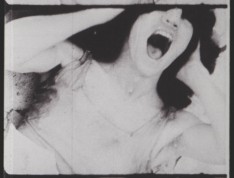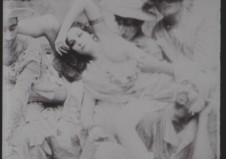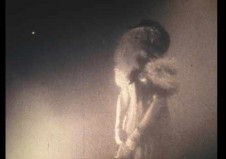Jack Smith: The Whole Fantasy

Jack Smith, Flaming Creatures, 1962-63 Film Still, Copyright Jack Smith Archive, Courtesy Gladstone Gallery, New York and Brussels
In conjunction with the MOCA exhibition Tongues Untied, Los Angeles Filmforum at MOCA is proud to present Jack Smith’s 16mm masterpiece, Flaming Creatures (1962-3). Despite its humble production values—it was derided in the Congressional Record as “five unrelated, badly filmed sequences”—this excessive celluloid celebration of polymorphous perversity was instantly recognized as a major achievement of the New American Cinema. Famously, it was just as quickly condemned by the Right. Banned, seized, and censored in a number of countries, Smith’s little stab at “moldiness” was eventually considered by the Supreme Court, and ultimately affectinged the way we interpret the First Amendment. Smith himself always insisted it was a comedy.
The screening also features Smith’s riotous Scotch Tape (1959-62) and I Was a Male Yvonne De Carlo (1967-70s), an unruly assemblage that has rarely been screened. The program will be introduced by Rebecca Matalon, MOCA Curatorial Assistant and organizer of Tongues Untied; and Madison Brookshire, MOCA Education Program Coordinator and Associate Programmer for Los Angeles Filmforum.
INFO education@moca.org or 213.621.1745
TICKETS $12 general admission, $7 students with valid ID
FREE for MOCA & Los Angeles Filmforum members; must present current membership card to claim free tickets.
Available in advance from Brown Paper Tickets at http://www.brownpapertickets.com/event/258310 or at the door.
“Flaming Creatures proposed an entirely new form of cine-glamour—one that owed everything and nothing to Hollywood’s.” –J. Hoberman
“[Jack Smith] has attained for the first time in motion pictures a high level of art that is absolutely lacking in decorum; and a treatment of sex which makes us aware of the restraint of all previous filmmakers.” –Jonas Mekas, Film Culture
Jack Smith (1932-1989) was a filmmaker, photographer, and performer whose singular work, searing intellect, and anarchic spirit has had a profound impact on generations of filmmakers and artists. Smith worked in many media, but always with a singular aesthetic that both celebrated and defied genre while suggesting new definitions of beauty, and sexuality, and the erotic. As Richard Foreman wrote: “Jack Smith is the hidden source of practically everything that’s of any interest in the so-called experimental American theater today.” Through his films, performances, writings, and uncompromising views on art and politics, Smith made an invaluable contribution to the underground art and thought of the twentieth century.
Programmed by Madison Brookshire
Acknowledgements:
Los Angeles Filmforum at MOCA is supported through both organizations by the Los Angeles County Board of Supervisors through the Los Angeles County Arts Commission. Additional support of Filmforum's screening series comes from the Mike Kelley Foundation for the Arts and the Department of Cultural Affairs, City of Los Angeles. We also depend on our members, ticket buyers, and individual donors.
Los Angeles Filmforum at MOCA furthers MOCA’s mission to be the defining museum of contemporary art with a bimonthly series of film and video screenings organized and co-presented by Los Angeles Filmforum—the city’s longest-running organization dedicated to weekly screenings of experimental film, documentaries, video art, and experimental animation.
For more on Los Angeles Filmforum, visit lafilmforum.org, or email lafilmforum@yahoo.com. For more information on MOCA, visit moca
Scotch Tape
By Jack Smith, 1959-62, 16mm, color, sound; 3 minutes
Featuring: Jerry Sims, Ken Jacobs, and Reese Haire; Sound Recording: Tony Conrad.
Shot on location in a rubble-strewn landscape that would later become Lincoln Center, this cut-in-camera Kodachrome gem leaps from the projector with undiminished energy for its brief duration. The title makes light of the presence of a piece of tape stuck in the camera’s gate during the shoot (and therefore visible throughout the entire film). In addition to all the ways it interacts with the rapidly shifting imagery, the tape also serves to remind us of the realities of no-budget filmmaking: shooting “short ends” and sharing a camera between productions, the same location, players, and even dirty triangle of tape can also be seen in Ken Jacobs’ epic, Star Spangled to Death (1957-2004). –Madison Brookshire
“For a three-minute film, Scotch Tape carries considerable conceptual weight. The title anticipates Warhol’s go-with-the-flow acceptance of cinematic ‘mistakes,’ even as it draws the viewer’s attention to the perceptual tension between the film’s actual surface and its represented depth. That Smith’s edited-in-camera montage juxtaposes long shots with extreme close-ups and involves radical shifts in focal length only serves to emphasize the tape’s presence. …
“Scotch Tape’s audio accompaniment was created three years later by Tony Conrad who, acting on Smith’s instructions, cut Peter Duchin’s rhumba “Carinhoso” to match the footage. Watching the resultant synch event, Conrad later recalled, had a decisive effect on his own life, even inspiring him to become a filmmaker… “ –J. Hoberman, Jack Smith and His Secret Flix, program notes, American Museum of the Moving Image, p. 6

Jack Smith, Flaming Creatures, 1962-63, Film Still Copyright Jack Smith Archive, Courtesy Gladstone Gallery, New York and Brussels
Flaming Creatures
By Jack Smith, 1962-3, 16mm, black and white, sound; 43 minutes
Featuring: Francis Francine, Sheila Bick, Joel Markman, Dolores Flores, Arnold, Judith Malina, and Marian Zazeela. Photography: Jack Smith. Assistant Director: Marc Schleifer. Sound Recording: Tony Conrad. Special Assistant: Dick Preston.
“At once primitive and sophisticated, hilarious and poignant, spontaneous and studied, frenzied and languid, crude and delicate, avant and nostalgic, gritty and fanciful, fresh and faded, innocent and jaded, high and low, raw and cooked, underground and camp, black and white and white on white, composed and decomposed, richly perverse and gloriously impoverished, Flaming Creatures was something new under the sun. Had Jack Smith produced nothing other than this amazing artifice, he would still rank among the great visionaries of American film.” –J. Hoberman, ““The Big Heat: The Making and Unmaking of Flaming Creatures,” Flaming Creature: Jack Smith and His Amazing Life and Times, pg. 155.

Jack Smith, I Was a Male Yvonne De Carlo, 1970, Film Still Copyright Jack Smith Archive, Courtesy Gladstone Gallery, New York and Brussels
I Was a Male Yvonne De Carlo
By Jack Smith, 1967-70, 16mm, black and white, sound on CD; 28 minutes
Restored by Jerry Tartaglia, 1997, with sound from the Jack Smith Record Collection.
"Few recordings exist of the live performances Jack Smith presented from 1968 into the mid-1980’s. Indeed, far more people saw Ron Vawter’s interpretation of one such performance, the 1981 What’s Underground About Marshmallows?, which formed the basis for the second act of his Roy Cohn/Jack Smith, than saw all of Smith’s performances combined.
“I Was a Male Yvonne De Carlo, which stars Smith himself, takes its title from one such piece—I Was a Male Yvonne De Carlo for the Lucky Landlord Underground, staged in the early 1980s. Shot mainly during the late '60s and edited a decade or more later, I Was a Male Yvonne De Carlo is one of several films and slide shows that feature the filmmaker as a mock celebrity. It opens with… several minutes of black and white footage of steam escaping from manholes ... [followed by] an interior scene of various creatures emerging from dry ice vapors - then shifts to show the filmmaker, clad in a leopard skin jump suit, attended by a nurse… . Violence erupts as the nurse takes out a whip to discipline the star's fans. … The action is post-scripted with footage of a steam shovel patrolling the rubble where the Broadway Central hotel once stood." –J. Hoberman, Jack Smith and His Secret Flix, American Museum of the Moving Image, program notes, p. 43
